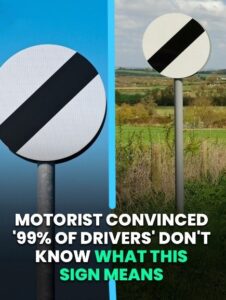Driver Sparks Online Debate After Revealing Most Motorists Misunderstand This Common UK Road Sign

A British driver has stirred up a surprising amount of discussion after claiming that “99% of drivers” on UK roads have no idea what one of the country’s most familiar signs actually means. The sign in question — a white circle with a bold black diagonal stripe — is something every learner encounters during their theory test, yet it seems to leave even experienced motorists second-guessing its purpose.
The sign officially marks the start of the national speed limit — but its meaning isn’t as straightforward as it looks. When a photo of it was shared on Reddit, users flooded the comments with jokes and confusion. Some sarcastically called it the “unlimited speed zone” or “national drifting area,” while others confessed they weren’t entirely sure how to interpret it. The light-hearted banter quickly revealed a deeper truth: many UK drivers have forgotten what the sign actually stands for.
So, what does it really mean?
According to the RAC, the black stripe indicates that all previous speed restrictions no longer apply and that the national speed limit is now in force. However, this limit isn’t the same for every vehicle — or every road — which often leads to misunderstanding.
Here’s how it breaks down:
-
Cars and motorcycles: up to 60 mph on single carriageways, 70 mph on dual carriageways and motorways.
-
Vans and light goods vehicles: 50 mph on single carriageways, 60 mph on dual carriageways.
-
Vehicles towing caravans or trailers: follow the same reduced limits as vans.
-
Built-up areas: generally remain at 30 mph unless otherwise posted.
Because these limits vary by vehicle type and road category, two drivers traveling side by side could legally drive at different maximum speeds — a detail many overlook.
Even so, motoring experts stress that the national speed limit is not a target. Drivers must still adapt to conditions — slowing down for poor weather, traffic, or visibility. In fog, ice, or heavy rain, driving at the top legal speed could be just as dangerous as breaking the law.
The confusion surrounding this single sign has reignited conversations about ongoing driver education. Many campaigners suggest that refresher lessons or updated theory tests for long-term drivers could help bridge the gap between what motorists learned years ago and how roads operate today.
In the end, the “mysterious” black-and-white sign doesn’t signal a free-for-all — it’s a reminder of responsibility. While it might spark jokes about “national drifting zones,” its real purpose is much simpler: to encourage safe, informed, and mindful driving on every journey.